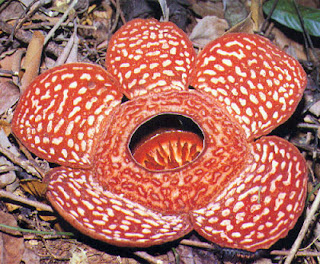Monday, March 12, 2007
Rare flower reappears in Banahaw
One of the rarest and most astonishing flowers in the world, including the very largest, is found only in Borneo and Sumatra! The Rafflesia flower starts as a small bud and can take over a year to flower. Rafflesia plants are parasitic, lacking both leaves and roots. The flower is not designed for beauty. In fact, the five fleshy, petal like lobes, marbled red and white, resemble dead meat and through chemical reaction the flower generates a strong odor of rotting flesh. This attracts carrion feeders drawn by the fleshy color pattern and the stench! After a few days, the Rafflesia flower turns brown and rots. Thus the world's rarest plant lives for a few days making it extremely difficult to see in the wild.
Jay Lim, program officer of Tanggol Kalikasan (TK), an environmental law center in Lucena, said they spotted the rafflesia late last year during an assessment hike of the mountain near Cristalino Falls where pilgrims used to put up their tents every Holy Week.
Citing records of known Mt. Banahaw species, rafflesia has long been a part of the mystical mountain’s rich forest wildlife.
Discovered in an Indonesian forest by a native guide working for an expedition in 1888, it was named after Thomas Stamford Raffles, the leader of the group.
Quezon Rep. Proceso Alcala, a noted environmentalist, has been introducing alternative livelihood projects for the hundreds of farmers who depend on slash-and-burn (kaingin) farming practice in the mountain.
The mountain suffered so much degradation not only from “kaingin” farming but also from the irresponsible practices of mountain climbers, modern pilgrims and urban nature trippers.
They left behind styrofoam boxes, empty water bottles and cans almost everywhere.
“Mt. Banahaw has long been being subjected to tremendous environmental pressure from religious pilgrims. Nothing is more divine than to let the environment return its pristine natural condition without human intrusion,” said environment lawyer Sheila de Leon, TK-Southern Tagalog executive director.
The park covers Sariaya, Candelaria, Tayabas, Lucban and Dolores towns all in Quezon, and Rizal, Nagcarlan, Liliw, Majayjay and San Pablo City in Laguna.
By Delfin Mallari Jr.InquirerLast updated 09:31pm (Mla time) 03/07/2007
http://mtbanahaw.blogspot.com/2007/03/rare-flower-reappears-in-banahaw.html




Comments :
Post a Comment